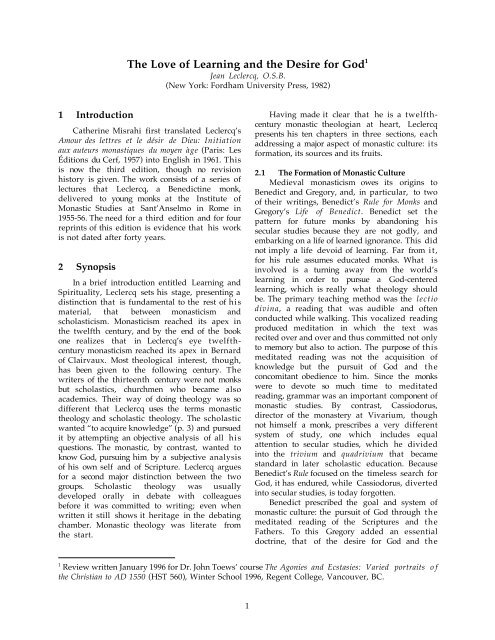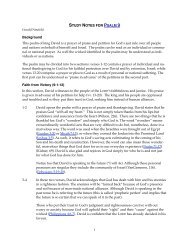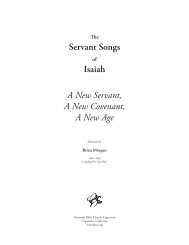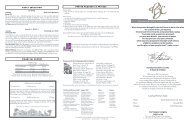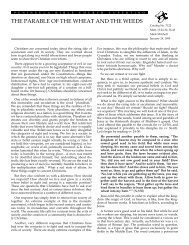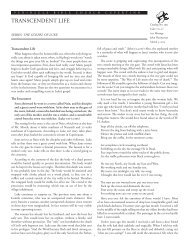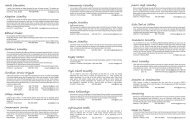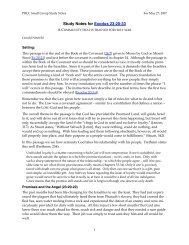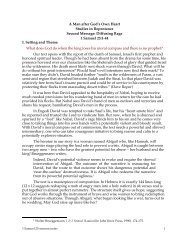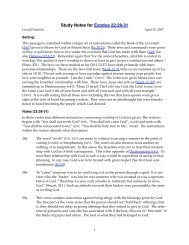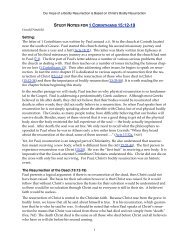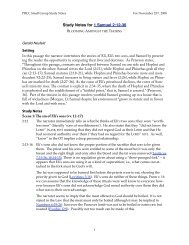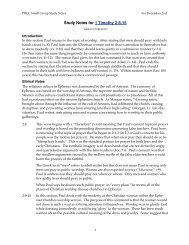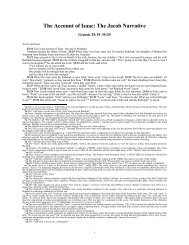The Love of Learning and the Desire for God
The Love of Learning and the Desire for God
The Love of Learning and the Desire for God
Create successful ePaper yourself
Turn your PDF publications into a flip-book with our unique Google optimized e-Paper software.
<strong>The</strong> <strong>Love</strong> <strong>of</strong> <strong>Learning</strong> <strong>and</strong> <strong>the</strong> <strong>Desire</strong> <strong>for</strong> <strong>God</strong> 1<br />
Jean Leclercq, O.S.B.<br />
(New York: Fordham University Press, 1982)<br />
1 Introduction<br />
Ca<strong>the</strong>rine Misrahi first translated Leclercq’s<br />
Amour des lettres et le désir de Dieu: Initiation<br />
aux auteurs monastiques du moyen àge (Paris: Les<br />
Éditions du Cerf, 1957) into English in 1961. This<br />
is now <strong>the</strong> third edition, though no revision<br />
history is given. <strong>The</strong> work consists <strong>of</strong> a series <strong>of</strong><br />
lectures that Leclercq, a Benedictine monk,<br />
delivered to young monks at <strong>the</strong> Institute <strong>of</strong><br />
Monastic Studies at Sant’Anselmo in Rome in<br />
1955-56. <strong>The</strong> need <strong>for</strong> a third edition <strong>and</strong> <strong>for</strong> four<br />
reprints <strong>of</strong> this edition is evidence that his work<br />
is not dated after <strong>for</strong>ty years.<br />
2 Synopsis<br />
In a brief introduction entitled <strong>Learning</strong> <strong>and</strong><br />
Spirituality, Leclercq sets his stage, presenting a<br />
distinction that is fundamental to <strong>the</strong> rest <strong>of</strong> his<br />
material, that between monasticism <strong>and</strong><br />
scholasticism. Monasticism reached its apex in<br />
<strong>the</strong> twelfth century, <strong>and</strong> by <strong>the</strong> end <strong>of</strong> <strong>the</strong> book<br />
one realizes that in Leclercq’s eye twelfthcentury<br />
monasticism reached its apex in Bernard<br />
<strong>of</strong> Clairvaux. Most <strong>the</strong>ological interest, though,<br />
has been given to <strong>the</strong> following century. <strong>The</strong><br />
writers <strong>of</strong> <strong>the</strong> thirteenth century were not monks<br />
but scholastics, churchmen who became also<br />
academics. <strong>The</strong>ir way <strong>of</strong> doing <strong>the</strong>ology was so<br />
different that Leclercq uses <strong>the</strong> terms monastic<br />
<strong>the</strong>ology <strong>and</strong> scholastic <strong>the</strong>ology. <strong>The</strong> scholastic<br />
wanted “to acquire knowledge” (p. 3) <strong>and</strong> pursued<br />
it by attempting an objective analysis <strong>of</strong> all his<br />
questions. <strong>The</strong> monastic, by contrast, wanted to<br />
know <strong>God</strong>, pursuing him by a subjective analysis<br />
<strong>of</strong> his own self <strong>and</strong> <strong>of</strong> Scripture. Leclercq argues<br />
<strong>for</strong> a second major distinction between <strong>the</strong> two<br />
groups. Scholastic <strong>the</strong>ology was usually<br />
developed orally in debate with colleagues<br />
be<strong>for</strong>e it was committed to writing; even when<br />
written it still shows it heritage in <strong>the</strong> debating<br />
chamber. Monastic <strong>the</strong>ology was literate from<br />
<strong>the</strong> start.<br />
Having made it clear that he is a twelfthcentury<br />
monastic <strong>the</strong>ologian at heart, Leclercq<br />
presents his ten chapters in three sections, each<br />
addressing a major aspect <strong>of</strong> monastic culture: its<br />
<strong>for</strong>mation, its sources <strong>and</strong> its fruits.<br />
2.1 <strong>The</strong> Formation <strong>of</strong> Monastic Culture<br />
Medieval monasticism owes its origins to<br />
Benedict <strong>and</strong> Gregory, <strong>and</strong>, in particular, to two<br />
<strong>of</strong> <strong>the</strong>ir writings, Benedict’s Rule <strong>for</strong> Monks <strong>and</strong><br />
Gregory’s Life <strong>of</strong> Benedict. Benedict set <strong>the</strong><br />
pattern <strong>for</strong> future monks by ab<strong>and</strong>oning his<br />
secular studies because <strong>the</strong>y are not godly, <strong>and</strong><br />
embarking on a life <strong>of</strong> learned ignorance. This did<br />
not imply a life devoid <strong>of</strong> learning. Far from i t ,<br />
<strong>for</strong> his rule assumes educated monks. What is<br />
involved is a turning away from <strong>the</strong> world’s<br />
learning in order to pursue a <strong>God</strong>-centered<br />
learning, which is really what <strong>the</strong>ology should<br />
be. <strong>The</strong> primary teaching method was <strong>the</strong> lectio<br />
divina, a reading that was audible <strong>and</strong> <strong>of</strong>ten<br />
conducted while walking. This vocalized reading<br />
produced meditation in which <strong>the</strong> text was<br />
recited over <strong>and</strong> over <strong>and</strong> thus committed not only<br />
to memory but also to action. <strong>The</strong> purpose <strong>of</strong> this<br />
meditated reading was not <strong>the</strong> acquisition <strong>of</strong><br />
knowledge but <strong>the</strong> pursuit <strong>of</strong> <strong>God</strong> <strong>and</strong> <strong>the</strong><br />
concomitant obedience to him. Since <strong>the</strong> monks<br />
were to devote so much time to meditated<br />
reading, grammar was an important component <strong>of</strong><br />
monastic studies. By contrast, Cassiodorus,<br />
director <strong>of</strong> <strong>the</strong> monastery at Vivarium, though<br />
not himself a monk, prescribes a very different<br />
system <strong>of</strong> study, one which includes equal<br />
attention to secular studies, which he divided<br />
into <strong>the</strong> trivium <strong>and</strong> quadrivium that became<br />
st<strong>and</strong>ard in later scholastic education. Because<br />
Benedict’s Rule focused on <strong>the</strong> timeless search <strong>for</strong><br />
<strong>God</strong>, it has endured, while Cassiodorus, diverted<br />
into secular studies, is today <strong>for</strong>gotten.<br />
Benedict prescribed <strong>the</strong> goal <strong>and</strong> system <strong>of</strong><br />
monastic culture: <strong>the</strong> pursuit <strong>of</strong> <strong>God</strong> through <strong>the</strong><br />
meditated reading <strong>of</strong> <strong>the</strong> Scriptures <strong>and</strong> <strong>the</strong><br />
Fa<strong>the</strong>rs. To this Gregory added an essential<br />
doctrine, that <strong>of</strong> <strong>the</strong> desire <strong>for</strong> <strong>God</strong> <strong>and</strong> <strong>the</strong><br />
1<br />
Review written January 1996 <strong>for</strong> Dr. John Toews’ course <strong>The</strong> Agonies <strong>and</strong> Ecstasies: Varied portraits o f<br />
<strong>the</strong> Christian to AD 1550 (HST 560), Winter School 1996, Regent College, Vancouver, BC.<br />
1
<strong>The</strong> <strong>Love</strong> <strong>of</strong> <strong>Learning</strong> <strong>and</strong> <strong>the</strong> <strong>Desire</strong> <strong>for</strong> <strong>God</strong> 2<br />
possession <strong>of</strong> <strong>God</strong> which alone satisfies that<br />
desire. Though rising to <strong>the</strong> highest <strong>of</strong>fice,<br />
Gregory wrote <strong>of</strong> <strong>the</strong> Christian life as a life <strong>of</strong><br />
detachment <strong>and</strong> desire: detachment from <strong>the</strong><br />
world <strong>and</strong> from sin, <strong>and</strong> an intense desire <strong>for</strong> <strong>God</strong>.<br />
<strong>The</strong> Christian who rightly appreciates his own<br />
sinfulness <strong>and</strong> consequent misery experiences a<br />
double ‘compunction’: a compunction <strong>of</strong> fear <strong>and</strong> a<br />
compunction <strong>of</strong> desire. This produces a pained<br />
spirit, distraught over <strong>the</strong> misery <strong>of</strong> sin but<br />
desiring <strong>God</strong>. Himself buffeted by suffering,<br />
Gregory saw that <strong>God</strong> awakens our desire <strong>for</strong> him<br />
by pressing on us through sin, through suffering or<br />
through temptation. Man must make himself<br />
sensitive <strong>and</strong> responsive to this pressure from<br />
<strong>God</strong>. <strong>The</strong> appropriate response is tears: tears <strong>of</strong><br />
repentance <strong>and</strong> tears <strong>of</strong> desire. Goaded by <strong>God</strong>,<br />
<strong>the</strong> soul takes flight like an eagle <strong>and</strong> soars<br />
toward <strong>God</strong> where it finds transcendent love <strong>and</strong><br />
peace. This finding <strong>of</strong> <strong>God</strong> has practical<br />
outworking in fruitful service to <strong>God</strong>. Alas, <strong>the</strong><br />
eagle’s flight is not always upward. <strong>The</strong> soul<br />
falls back, wearied, only to recover <strong>and</strong> soar<br />
upward again, stronger <strong>for</strong> <strong>the</strong> experience.<br />
Gregory contributed to <strong>the</strong> monastic tradition an<br />
unsurpassed <strong>the</strong>ology <strong>of</strong> <strong>the</strong> experiential<br />
relationship between <strong>God</strong> <strong>and</strong> man.<br />
It took ano<strong>the</strong>r three centuries <strong>for</strong> fullfledged<br />
medieval monasticism to be built upon<br />
<strong>the</strong> foundations <strong>of</strong> early sixth-century Benedict<br />
<strong>and</strong> late sixth-century Gregory. <strong>The</strong> missing<br />
ingredient, <strong>the</strong> third <strong>for</strong>mative influence, was<br />
<strong>the</strong> reawakening <strong>of</strong> culture following <strong>the</strong><br />
depredations <strong>of</strong> <strong>the</strong> Germanic tribes that had<br />
brought down <strong>the</strong> rotten Roman Empire. This<br />
renaissance, occurring during <strong>the</strong> Carolingian<br />
period <strong>of</strong> <strong>the</strong> late eight <strong>and</strong> early ninth centuries,<br />
is <strong>the</strong> subject <strong>of</strong> Leclercq’s third chapter. Gregory<br />
had sent missionary monks to Engl<strong>and</strong>, carrying<br />
not only Roman Christianity but also <strong>the</strong><br />
remnants <strong>of</strong> Roman culture. While this new<br />
learning thrived in Engl<strong>and</strong> it died out on t h e<br />
continent as society <strong>and</strong> culture dissolved. English<br />
missionary monks, such as Boniface, returned to<br />
<strong>the</strong> continent bringing <strong>the</strong>ir preserved Latin<br />
culture with <strong>the</strong>m. Around 780 Charlemagne<br />
initiated a renaissance <strong>of</strong> Western culture. This<br />
revival <strong>of</strong> culture was accomplished through<br />
three men from monastic backgrounds: Paul <strong>the</strong><br />
Deacon from <strong>the</strong> monastery at Monte Cassino<br />
revised <strong>the</strong> liturgy <strong>and</strong> wrote on grammar; Alcuin<br />
<strong>of</strong> York organized a royal school in Aachen <strong>and</strong><br />
later in Tours in which were raised a new<br />
generation <strong>of</strong> literary young men; St. Benedict <strong>of</strong><br />
Aniane, “sometimes considered <strong>the</strong> second founder<br />
<strong>of</strong> Benedictine monasticism” (p. 43), revived <strong>the</strong><br />
monasteries by recalling <strong>the</strong>ir attention to Jerome<br />
<strong>and</strong> Gregory <strong>and</strong> to <strong>the</strong> pursuit <strong>of</strong> <strong>God</strong>.<br />
<strong>The</strong>se, <strong>the</strong>n, are <strong>the</strong> three <strong>for</strong>mative<br />
influences that shaped medieval monastic<br />
culture: Benedict’s rule <strong>of</strong> study, Gregory’ doctrine<br />
<strong>of</strong> desire, <strong>and</strong> <strong>the</strong> Carolingian renaissance.<br />
2.2 <strong>The</strong> Sources <strong>of</strong> Monastic Culture<br />
Leclercq turns to <strong>the</strong> sources <strong>of</strong> monastic<br />
culture, which he covers in four heads: devotion<br />
to heaven, sacred learning, <strong>the</strong> ancient<br />
traditional spirituality, <strong>and</strong> liberal studies.<br />
Medieval monastic culture has two types <strong>of</strong><br />
sources, literary texts assimilated through<br />
meditative reading, <strong>and</strong> experience, <strong>of</strong> which <strong>the</strong><br />
most important is that experience which “induces<br />
<strong>the</strong> desire to reach <strong>the</strong> culmination <strong>of</strong> this<br />
experience” (p. 53). <strong>The</strong> content <strong>of</strong> monastic<br />
culture can be summarized in two words: grammar<br />
<strong>and</strong> spirituality. “On <strong>the</strong> one h<strong>and</strong>, learning is<br />
necessary if one is to approach <strong>God</strong> <strong>and</strong> to express<br />
what is perceived <strong>of</strong> Him; on <strong>the</strong> o<strong>the</strong>r h<strong>and</strong>,<br />
literature must be continually transcended <strong>and</strong><br />
elevated in <strong>the</strong> striving to attain life” (p. 53).<br />
<strong>The</strong> most important <strong>of</strong> <strong>the</strong> <strong>the</strong>mes which kept<br />
<strong>the</strong> monks faithful to <strong>the</strong> vision <strong>of</strong> Gregory, in<br />
<strong>the</strong> transcendent <strong>and</strong> <strong>the</strong> eschatological, was<br />
devotion to heaven. We find this heavenlymindedness<br />
in <strong>the</strong>ir literature under <strong>the</strong> topics <strong>of</strong><br />
<strong>the</strong> heavenly Jerusalem <strong>of</strong> which <strong>the</strong> monastery<br />
is an earthly anticipation, to which is attached<br />
<strong>the</strong> ideas <strong>of</strong> Temple <strong>and</strong> Tabernacle. With his<br />
gaze set on Jerusalem <strong>the</strong> mediaeval monk was<br />
fond <strong>of</strong> writing about Christ’s ascension <strong>the</strong>reto,<br />
<strong>and</strong> <strong>of</strong> his Transfiguration. Consideration <strong>of</strong> <strong>God</strong><br />
in glory led to consideration <strong>of</strong> <strong>the</strong> angels<br />
rendering him praise. <strong>The</strong> desire <strong>for</strong> heaven<br />
produced a literature on tears. This desire <strong>for</strong><br />
heaven had practical outworkings. It produced an<br />
intense joy in <strong>the</strong> soul as a <strong>for</strong>etaste <strong>of</strong> heaven,<br />
<strong>and</strong> a commitment to a life <strong>of</strong> leisure, albeit a<br />
very busy leisure, but one in which one has<br />
deliberately turned aside from <strong>the</strong> cares <strong>of</strong> <strong>the</strong><br />
world. This desire is <strong>the</strong> fruit not <strong>of</strong> study <strong>and</strong> <strong>the</strong><br />
search <strong>for</strong> knowledge, but ra<strong>the</strong>r <strong>of</strong> contemplation<br />
that springs from faith, hope <strong>and</strong> love, activities<br />
<strong>of</strong> <strong>the</strong> heart not <strong>the</strong> mind.<br />
<strong>The</strong> monks took <strong>the</strong>ir learning from three<br />
literary sources: Scripture, <strong>the</strong> Fa<strong>the</strong>rs, <strong>and</strong><br />
classical literature. Grammar was studied as an<br />
‘introduction to Scripture’ Here Leclercq returns to<br />
<strong>the</strong> distinction he drew in <strong>the</strong> preface, that
<strong>The</strong> <strong>Love</strong> <strong>of</strong> <strong>Learning</strong> <strong>and</strong> <strong>the</strong> <strong>Desire</strong> <strong>for</strong> <strong>God</strong> 3<br />
between monasticism <strong>and</strong> scholasticism. <strong>The</strong><br />
monastic learns through meditative reading;<br />
though he may start with grammar he seeks<br />
wisdom <strong>and</strong> appreciation with <strong>the</strong> ultimate goal<br />
being desire <strong>for</strong> heaven. <strong>The</strong> scholastic, by<br />
debating with <strong>the</strong> text, seeks science <strong>and</strong><br />
knowledge. <strong>The</strong> monastic triplet <strong>of</strong> reading,<br />
meditation <strong>and</strong> prayer produced a “rumination<br />
<strong>and</strong> reminiscence” (p. 75) <strong>of</strong> Scripture. This rich<br />
knowledge <strong>of</strong> Scripture gave <strong>the</strong> ability to roam<br />
freely throughout <strong>the</strong> entire Bible, attuned to<br />
allusion, <strong>and</strong> gave <strong>the</strong>m a vivid Biblical<br />
imagination. While <strong>the</strong> scholastics consulted<br />
written concordances, <strong>the</strong> monastics did not have<br />
to—<strong>the</strong>y had <strong>the</strong> entire Scriptures on instant<br />
mental recall. Monastic exegesis was both literal<br />
<strong>and</strong> mystical, literal because <strong>of</strong> <strong>the</strong> interest in<br />
grammar <strong>and</strong> in reading, mystical because<br />
Scripture was not a source <strong>for</strong> knowledge but t h e<br />
message <strong>of</strong> salvation from <strong>God</strong>. <strong>The</strong> Old<br />
Testament was seen not as a history book, but as<br />
<strong>the</strong> first half <strong>of</strong> this story <strong>of</strong> salvation. Though i t<br />
might have a historical meaning, it was always<br />
interpreted as <strong>for</strong>eshadowing New Testament<br />
salvation. <strong>The</strong> most read <strong>and</strong> most frequently<br />
commentated book <strong>of</strong> Scripture was <strong>the</strong> Song <strong>of</strong><br />
Songs. Whereas <strong>the</strong> scholastics interpreted <strong>the</strong><br />
Song more abstractly as <strong>God</strong>’s relation to <strong>the</strong><br />
Church as a whole, <strong>the</strong> monastics saw it as <strong>God</strong>’s<br />
intensely personal relationship to <strong>the</strong> individual<br />
believer; it <strong>the</strong>re<strong>for</strong>e expressed <strong>the</strong>ir whole<br />
<strong>the</strong>ology, <strong>the</strong>ir whole goal in life.<br />
Benedict urged <strong>the</strong> monks to read <strong>the</strong><br />
Fa<strong>the</strong>rs. <strong>The</strong> monastic monks considered Benedict<br />
to be himself one <strong>of</strong> <strong>the</strong> Fa<strong>the</strong>rs. <strong>The</strong>re<strong>for</strong>e, when<br />
monasticism was strong <strong>the</strong> monks turned to <strong>the</strong><br />
Fa<strong>the</strong>rs, <strong>and</strong> especially to <strong>the</strong> Greek Fa<strong>the</strong>r<br />
Origen. Of <strong>the</strong> Latin Fa<strong>the</strong>rs, most frequently<br />
consulted were Jerome <strong>for</strong> his linguistic skills, <strong>for</strong><br />
his letters <strong>and</strong> <strong>for</strong> his thoughts on asceticism; <strong>and</strong><br />
Augustine <strong>for</strong> his writings on monasticism. <strong>The</strong><br />
scholastics searched <strong>the</strong> Fa<strong>the</strong>rs <strong>for</strong><br />
metaphysical ideas, <strong>the</strong> monastics sought help in<br />
living <strong>the</strong> monastic life, i.e. in pursuing <strong>God</strong>. <strong>The</strong><br />
most important monastic ideal was that <strong>of</strong><br />
Anthony; his life was <strong>the</strong>re<strong>for</strong>e widely read. <strong>The</strong><br />
monks appreciated <strong>the</strong> Fa<strong>the</strong>rs <strong>for</strong> <strong>the</strong>ir literary<br />
quality <strong>and</strong> <strong>for</strong> <strong>the</strong>ir spiritual quality. <strong>The</strong>y<br />
remained patristic at heart while <strong>the</strong> scholastics<br />
spun <strong>of</strong>f into philosophical speculation. Leclercq<br />
describes Bernard <strong>of</strong> Clairvaux as <strong>the</strong> last <strong>of</strong> <strong>the</strong><br />
Fa<strong>the</strong>rs.<br />
After <strong>the</strong> Scriptures <strong>and</strong> <strong>the</strong> Fa<strong>the</strong>rs, <strong>the</strong><br />
third source <strong>of</strong> medieval monastic culture is <strong>the</strong><br />
classical literature <strong>of</strong> pagan antiquity, topic <strong>of</strong><br />
<strong>the</strong> seventh chapter. <strong>The</strong> classics were studied in<br />
<strong>the</strong> monastic schools. Committed to studying <strong>the</strong><br />
classics, <strong>the</strong>y con<strong>for</strong>med <strong>the</strong>m to <strong>the</strong>ir <strong>the</strong>ology<br />
by Christianizing <strong>the</strong>m through allegorical<br />
interpretation. “Although it was generally<br />
recognized that <strong>the</strong>se authors were pagans, i t<br />
was <strong>the</strong> important thing <strong>for</strong> medieval monks that<br />
<strong>the</strong>y should make use <strong>of</strong> <strong>the</strong>m as Christians” (p.<br />
117). This reinterpretation <strong>of</strong> <strong>the</strong> classics<br />
extended to archaeological remains: statues <strong>of</strong><br />
emperors became <strong>the</strong> saints, <strong>and</strong> mythical<br />
creatures were incorporated into religious art.<br />
Leclercq quotes Boutemy-f. Vercauten in<br />
pondering <strong>the</strong> clash this must have produced in<br />
<strong>the</strong> monks between <strong>the</strong>ir love <strong>for</strong> classical<br />
antiquity <strong>and</strong> <strong>the</strong>ir desire to destroy paganism.<br />
<strong>The</strong> monastic writers consciously <strong>and</strong><br />
subconsciously borrowed from <strong>the</strong> pagan classical<br />
authors, but <strong>the</strong>ir desire was not to create a neoclassicism<br />
as did humanists <strong>of</strong> <strong>the</strong> renaissance<br />
who were torn between two cultures, pagan <strong>and</strong><br />
Christian. Ra<strong>the</strong>r <strong>the</strong>y appreciated <strong>the</strong> beauty<br />
<strong>the</strong>y saw in <strong>the</strong> classic authors <strong>and</strong> adapted it to<br />
<strong>the</strong>ir own Christian ends. This appreciation <strong>for</strong><br />
beauty extended to nature, poetry <strong>and</strong> humor,<br />
lending great artistry to <strong>the</strong>ir writings.<br />
Meanwhile, scholastic humanism was focusing<br />
more <strong>and</strong> more on dialectics, valuing clarity <strong>of</strong><br />
argument over artistic expression with <strong>the</strong> result<br />
that “<strong>the</strong> language <strong>of</strong> orators <strong>and</strong> poets [gave]<br />
place to that <strong>of</strong> metaphysicians <strong>and</strong> logicians”<br />
(p. 142 quoting Hubert).<br />
2.3 <strong>The</strong> Fruits <strong>of</strong> Monastic Culture<br />
In his third section, Leclercq describes <strong>the</strong><br />
fruits produced by this monastic culture. He does<br />
so under three heads: literary genres, monastic<br />
<strong>the</strong>ology, <strong>and</strong> <strong>the</strong> liturgy.<br />
While <strong>the</strong> scholastics developed <strong>the</strong><br />
literary genre <strong>of</strong> <strong>the</strong> abstract question <strong>and</strong> <strong>the</strong><br />
dispute, <strong>the</strong> monastics stuck to more concrete<br />
genres, generally addressing <strong>the</strong>ir works to a<br />
specific audience than into thin air. Be <strong>the</strong>y<br />
letters, dialogs, histories, sermons or<br />
commentaries, <strong>the</strong>y wrote to edify. Thus <strong>the</strong>ir<br />
sermons <strong>and</strong> commentaries are devotional in<br />
nature ra<strong>the</strong>r than prolonged explanations <strong>of</strong><br />
texts. Often <strong>the</strong> monks lived by <strong>the</strong> rule <strong>of</strong><br />
silence. Unable to engage, as <strong>the</strong> scholastics, in<br />
oral debate with one ano<strong>the</strong>r, <strong>the</strong>y meditated<br />
long <strong>and</strong> hard. When finally <strong>the</strong>y did express<br />
<strong>the</strong>mselves it was in written <strong>for</strong>m. <strong>The</strong>se writings<br />
were <strong>of</strong> high literary quality, <strong>the</strong> fruit <strong>of</strong> much
<strong>The</strong> <strong>Love</strong> <strong>of</strong> <strong>Learning</strong> <strong>and</strong> <strong>the</strong> <strong>Desire</strong> <strong>for</strong> <strong>God</strong> 4<br />
reading, <strong>and</strong> <strong>of</strong> high spiritual quality, <strong>the</strong> fruit<br />
<strong>of</strong> much meditation. It was <strong>the</strong> monks who kept<br />
alive <strong>the</strong> interest in history, evident in both<br />
<strong>the</strong>ir reading <strong>and</strong> writing. <strong>The</strong> monks knew <strong>and</strong><br />
appreciated <strong>the</strong> classical historians. <strong>The</strong>y also<br />
wanted to preserve remembrance <strong>of</strong> <strong>the</strong> past.<br />
While <strong>the</strong> scholastics looked ahead, <strong>the</strong><br />
monastics looked back, though none<strong>the</strong>less with<br />
<strong>the</strong>ir spiritual gaze steadfastly <strong>for</strong>ward on <strong>the</strong><br />
new Jerusalem. <strong>The</strong>y wrote history to render<br />
praise to <strong>God</strong> <strong>for</strong> his sovereign superintendence <strong>of</strong><br />
history, <strong>and</strong> to <strong>of</strong>fer to <strong>the</strong>ir readers salient<br />
lessons: good role models to be copied <strong>and</strong> bad role<br />
models to be avoided. History was interpreted<br />
religiously in light <strong>of</strong> <strong>the</strong> Church. “<strong>The</strong> monks<br />
have described fewer battles than ceremonies”<br />
(p. 159). One sub-genre <strong>of</strong> this historiography<br />
was hagiography, <strong>the</strong> recording <strong>of</strong> <strong>the</strong> lives <strong>of</strong><br />
<strong>the</strong> saints. What was important in <strong>the</strong> life <strong>of</strong> <strong>the</strong><br />
saint was not <strong>the</strong> details <strong>of</strong> his life but his<br />
exercise <strong>of</strong> virtue, <strong>the</strong> recitation <strong>of</strong> which<br />
produces praise to <strong>God</strong>, <strong>and</strong> a model <strong>for</strong> imitation.<br />
When historical facts were lacking <strong>the</strong>y were<br />
created in accordance with certain conventional<br />
<strong>the</strong>mes. “<strong>The</strong>ir design was not to relate true<br />
stories, but to expound a moral doctrine that was<br />
always true” (p. 164). O<strong>the</strong>r lives were written to<br />
assist in <strong>the</strong> process <strong>of</strong> canonization, in which <strong>the</strong><br />
marvellous or miraculous was an important<br />
element. “Medieval man took more interest in<br />
permanent <strong>and</strong> universal ideas than in specific<br />
events transitory in nature. To underst<strong>and</strong> <strong>the</strong>m,<br />
one must adopt <strong>the</strong>ir point <strong>of</strong> view. Once this is<br />
done, legend becomes, in a sense <strong>the</strong>y <strong>the</strong>mselves<br />
would have approved, truer than history” (p.<br />
166).<br />
<strong>The</strong> most common genre <strong>of</strong> monastic literature<br />
is <strong>the</strong> sermon. It <strong>for</strong>med part <strong>of</strong> <strong>the</strong> regular<br />
monastic observance. <strong>The</strong>ir preaching was<br />
devotional, practical, simple <strong>and</strong> edifying. By<br />
contrast, scholastic preaching became<br />
increasingly complicated, <strong>the</strong>oretical <strong>and</strong> rigidly<br />
logical. As a result, scholastic sermons are no<br />
longer read but monastic sermons are.<br />
Ano<strong>the</strong>r common genre is <strong>the</strong> letter. <strong>The</strong><br />
Benedictine vow <strong>of</strong> silence, <strong>of</strong> stability, <strong>and</strong> <strong>of</strong><br />
cloistered life, left letters as <strong>the</strong> usual <strong>for</strong>m <strong>of</strong><br />
communication between monks, whe<strong>the</strong>r within<br />
<strong>the</strong> same house or in different houses. Indeed,<br />
Benedict in his rule had covered <strong>the</strong> sending <strong>and</strong><br />
receipt <strong>of</strong> letters. Since all letters were approved<br />
by <strong>the</strong> abbot, all were edifying. <strong>The</strong>se letters<br />
might be exhortations to <strong>for</strong>mer peers on <strong>the</strong><br />
outside to join one in <strong>the</strong> monastery, letters <strong>of</strong><br />
encouragement or spiritual direction, ongoing<br />
doctrinal discussions, or letters <strong>of</strong> friendship,<br />
written merely <strong>for</strong> <strong>the</strong> purpose <strong>of</strong> bringing joy to<br />
<strong>the</strong> recipient. Ano<strong>the</strong>r genre <strong>of</strong> writing, <strong>the</strong><br />
florilegium was a collection <strong>of</strong> favorite texts,<br />
generally ascetic or mystical in character,<br />
compiled <strong>for</strong> convenient meditation.<br />
Leclercq has already distinguished monastic<br />
<strong>the</strong>ology from scholastic <strong>the</strong>ology. He devotes<br />
<strong>the</strong> ninth chapter to a study <strong>of</strong> monastic<br />
<strong>the</strong>ology. He borrows Congar’s definition <strong>of</strong><br />
<strong>the</strong>ology as a ‘discipline in which <strong>the</strong> truths <strong>of</strong><br />
<strong>the</strong> Christian religion, based on <strong>and</strong> illuminated<br />
by revelation, are interpreted, developed, <strong>and</strong><br />
ordered into a body <strong>of</strong> doctrine’ (p. 192). While<br />
<strong>the</strong>re is no doubt that <strong>the</strong> scholastics developed a<br />
<strong>the</strong>ology, it is now recognized that monastic<br />
thought is equally deserving <strong>of</strong> being called a<br />
<strong>the</strong>ology. During <strong>the</strong> medieval period, Christian<br />
reflection took place in <strong>the</strong> monasteries <strong>and</strong> in<br />
<strong>the</strong> town schools. <strong>The</strong>re were two types <strong>of</strong><br />
schools, monks’ schools <strong>for</strong> young men preparing<br />
<strong>for</strong> <strong>the</strong> contemplative life <strong>of</strong> <strong>the</strong> monastery, <strong>and</strong><br />
clerical schools <strong>for</strong> those training <strong>for</strong> <strong>the</strong> active<br />
life <strong>of</strong> <strong>the</strong> church. Scholastic <strong>the</strong>ology was born<br />
in <strong>the</strong>se urban clerical schools. <strong>The</strong> monks,<br />
emphasizing grammar, learnt Scripture <strong>and</strong> kept<br />
<strong>the</strong> mystical, artistic language <strong>of</strong> Scripture. <strong>The</strong><br />
scholastics, emphasizing logic <strong>and</strong> clarity,<br />
reduced <strong>the</strong> Bible’s poetic word-pictures to<br />
abstract philosophical concepts, creating an<br />
increasingly technical language. <strong>The</strong> monks<br />
cherished <strong>the</strong> writings <strong>of</strong> <strong>the</strong> past, while <strong>the</strong><br />
scholastics sought new solutions to new questions.<br />
<strong>The</strong> scholastics reduced <strong>the</strong>ology to just ano<strong>the</strong>r<br />
liberal discipline over which <strong>the</strong>y held<br />
pr<strong>of</strong>essional disputes. <strong>The</strong> monks retained a sense<br />
<strong>of</strong> respect <strong>and</strong> mystery <strong>for</strong> Scripture. Bernard<br />
explained, “This sacrament is great; it must be<br />
venerated, not scrutinized.” Scholasticism led to<br />
self-inflation, producing a state <strong>of</strong> agitation not<br />
conducive to <strong>the</strong> contemplative life, <strong>and</strong><br />
distracting <strong>the</strong> spirit from <strong>the</strong> undivided search<br />
<strong>for</strong> <strong>God</strong>, distracting it with numerous superfluous<br />
questions. <strong>The</strong> monks sought simplicity, not <strong>the</strong><br />
simplicity <strong>of</strong> ignorance, but that <strong>of</strong> a single aim:<br />
“[t]o seek <strong>God</strong>, not to discuss Him” (p. 205). Such<br />
simplicity maintained humility. Monastic<br />
<strong>the</strong>ology was not totally devoid <strong>of</strong> speculation;<br />
<strong>the</strong>re is an objective knowledge <strong>of</strong> <strong>God</strong> but i t<br />
should always produce a subjective, personal<br />
knowledge <strong>of</strong> Him. <strong>The</strong> knowledge <strong>of</strong> <strong>God</strong> should<br />
be essentially religious <strong>and</strong> experiential. <strong>The</strong> two<br />
main foci <strong>of</strong> monastic <strong>the</strong>ology are <strong>the</strong>re<strong>for</strong>e <strong>the</strong>
<strong>The</strong> <strong>Love</strong> <strong>of</strong> <strong>Learning</strong> <strong>and</strong> <strong>the</strong> <strong>Desire</strong> <strong>for</strong> <strong>God</strong> 5<br />
mystery <strong>of</strong> salvation, man’s objective st<strong>and</strong>ing<br />
be<strong>for</strong>e <strong>God</strong>; <strong>and</strong> <strong>the</strong> mystery <strong>of</strong> union with <strong>God</strong>,<br />
man’s subjective st<strong>and</strong>ing be<strong>for</strong>e <strong>God</strong>. <strong>The</strong><br />
Benedictines focused on <strong>the</strong> <strong>for</strong>mer, <strong>the</strong><br />
Cistercians on <strong>the</strong> latter. “Monastic <strong>the</strong>ology is a<br />
<strong>the</strong>ology <strong>of</strong> admiration <strong>and</strong> <strong>the</strong>re<strong>for</strong>e greater<br />
than a <strong>the</strong>ology <strong>of</strong> speculation. Admiration,<br />
speculation: both words describe <strong>the</strong> act <strong>of</strong><br />
looking. But <strong>the</strong> gaze <strong>of</strong> admiration adds<br />
something to <strong>the</strong> gaze <strong>of</strong> speculation. It does not<br />
necessarily see far<strong>the</strong>r, but <strong>the</strong> little it does<br />
perceive is enough to fill <strong>the</strong> whole soul <strong>of</strong> <strong>the</strong><br />
contemplative with joy <strong>and</strong> thanksgiving.” (p.<br />
226)<br />
Leclercq’s final chapter concerns <strong>the</strong> liturgy<br />
which he reserves <strong>for</strong> last “because it is linked<br />
with all o<strong>the</strong>r aspects <strong>of</strong> monastic life” (p. 236).<br />
<strong>The</strong> entire life <strong>of</strong> <strong>the</strong> monk revolved around <strong>the</strong><br />
liturgy. New liturgical texts were constantly<br />
being developed, as new feasts were added to <strong>the</strong><br />
calendar, or in response to changes in literary <strong>and</strong><br />
musical tastes. <strong>The</strong>se texts were drawn primarily<br />
from <strong>the</strong> Scriptures <strong>and</strong> from <strong>the</strong> Fa<strong>the</strong>rs. This<br />
daily experience <strong>of</strong> <strong>the</strong> liturgy influenced <strong>the</strong><br />
o<strong>the</strong>r writings <strong>of</strong> <strong>the</strong> monks, producing an<br />
emphasis on ecclesiology since worship took<br />
place in <strong>the</strong> context <strong>of</strong> <strong>the</strong> church, <strong>and</strong> on<br />
eschatology since worship looked <strong>for</strong>ward to<br />
union with <strong>God</strong>. <strong>The</strong> liturgy was <strong>the</strong> culmination<br />
<strong>of</strong> monastic <strong>the</strong>ology. “In <strong>the</strong> liturgy, love <strong>of</strong><br />
learning <strong>and</strong> desire <strong>for</strong> <strong>God</strong> find perfect<br />
reconciliation” (p. 251).<br />
2.4 Epilogue<br />
Leclercq concludes his work with a brief<br />
epilogue entitled Literature <strong>and</strong> <strong>the</strong> Mystical<br />
Life. Although <strong>the</strong> monasteries always were<br />
centers <strong>of</strong> spiritual life, <strong>the</strong>re were particular<br />
periods when <strong>the</strong>y flourished, producing a<br />
remarkable body <strong>of</strong> literature. It sought to keep<br />
alive <strong>the</strong> ancient literature <strong>of</strong> <strong>the</strong> Scriptures <strong>and</strong><br />
<strong>the</strong> Fa<strong>the</strong>rs. It was a literature <strong>of</strong> learned men,<br />
but also <strong>of</strong> mystics who are interested in learning<br />
only in so far as it stimulated an appetite <strong>for</strong> <strong>God</strong>.<br />
It was <strong>the</strong> product <strong>of</strong> great cultural attainment<br />
<strong>and</strong> <strong>of</strong> great spiritual attainment. Though <strong>the</strong>y<br />
were learned, cultured, literary men, <strong>the</strong>y were<br />
at <strong>the</strong> same time simple-minded, detached from<br />
interest in self or <strong>the</strong> world, <strong>and</strong> writing from<br />
experience not speculation. It is <strong>the</strong> combination<br />
<strong>of</strong> holiness <strong>and</strong> literary genius that gives <strong>the</strong>ir<br />
writings a lasting appeal. When a writer such as<br />
Bernard is totally absorbed with <strong>God</strong>, as in his<br />
sermons on <strong>the</strong> Song <strong>of</strong> Songs, his “art resides<br />
solely in <strong>the</strong> rhythm <strong>of</strong> <strong>the</strong> sentences which is<br />
attuned to an inner rhythm born <strong>of</strong> <strong>the</strong> possession<br />
<strong>of</strong> <strong>God</strong>” (p. 267f).<br />
<strong>The</strong> book ends with five one-page<br />
appendices, whose purpose is not clear.<br />
3 Evaluation<br />
Leclercq reminds us in <strong>the</strong> first sentence <strong>of</strong> his<br />
preface that he is a monk addressing o<strong>the</strong>r<br />
monks. It is <strong>the</strong>re<strong>for</strong>e only to be expected that he<br />
should present a very favorable history <strong>of</strong><br />
medieval monasticism. It has become trendy <strong>for</strong><br />
modern historians, even evangelical historians,<br />
to strive <strong>for</strong> objectivity in <strong>the</strong> name <strong>of</strong> academic<br />
excellence. This produces church histories devoid<br />
<strong>of</strong> reference to <strong>God</strong>, something that would have<br />
been absurd to Leclercq <strong>and</strong> his beloved monks<br />
alike. <strong>The</strong> distinction Leclercq draws between<br />
monastic <strong>the</strong>ology <strong>and</strong> scholastic <strong>the</strong>ology could<br />
be applied to contemporary studies in church<br />
history.<br />
As a monk addressing monks, Leclercq assumes<br />
that his hearers are familiar with Latin <strong>and</strong><br />
with monastic history. His Latin quotations are<br />
frequent; rarely are <strong>the</strong>y translated. <strong>The</strong> book is<br />
not a history <strong>of</strong> medieval monasticism; it is<br />
assumed <strong>the</strong> monks already knew <strong>the</strong>ir history.<br />
Instead it is what <strong>the</strong> subtitle proclaims it to be:<br />
a study <strong>of</strong> monastic culture. Consequently, <strong>the</strong><br />
reader who does not know <strong>the</strong> broad outline <strong>of</strong><br />
monastic history will be a little lost. As <strong>for</strong> <strong>the</strong><br />
Latin, I cannot judge whe<strong>the</strong>r I missed anything<br />
or not.<br />
<strong>The</strong> book is actually not quite as proclaimed<br />
by its subtitle, “A Study <strong>of</strong> Monastic Culture.”<br />
One is surprised to find no description <strong>of</strong> early<br />
monasticism <strong>of</strong> ei<strong>the</strong>r north Africa or Celtic<br />
Britain. Fur<strong>the</strong>rmore, Leclercq’s focus on<br />
literature in his concluding epilogue leaves one<br />
dissatisfied that he has ignored <strong>the</strong> rest <strong>of</strong><br />
culture. A glance at <strong>the</strong> copyright page, though,<br />
shows that Leclercq’s objective, as described in<br />
<strong>the</strong> subtitle <strong>of</strong> his French original, was initiation<br />
aux auteurs monastiques du moyen àge, an<br />
introduction to monastic authors <strong>of</strong> <strong>the</strong> Middle<br />
Age. <strong>The</strong> English subtitle renders <strong>the</strong> reader a<br />
double disservice by ignoring this emphasis on<br />
<strong>the</strong> medieval era <strong>and</strong> on literature.


